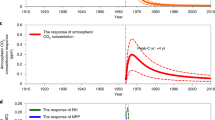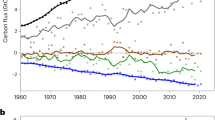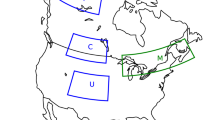Abstract
Earth system models simulate prominent terrestrial carbon-cycle responses to anthropogenically forced changes in climate and atmospheric composition over the twenty-first century1,2,3,4. The rate and magnitude of the forced climate change is routinely evaluated relative to unforced, or natural, variability using a multi-member ensemble of simulations5,6,7,8. However, Earth system model carbon-cycle analyses do not account for unforced variability1,2,3,4,9. To investigate unforced terrestrial carbon-cycle variability, we analyse ensembles from the Coupled Model Intercomparison Project (CMIP5), focusing on the Community Climate System Model (CCSM4). The unforced variability of CCSM4 is comparable to that observed at the Harvard Forest eddy covariance flux tower site. Over the twenty-first century, unforced variability in land–atmosphere CO2 flux is larger than the forced response at decadal timescales in many areas of the world, precluding detection of the forced carbon-cycle change. Only after several decades does the forced carbon signal consistently emerge in CCSM4 and other models for the business-as-usual radiative forcing scenario (RCP8.5). Grid-cell variability in time of emergence is large, but decreases at regional scales. To attribute changes in the terrestrial carbon cycle to anthropogenic forcings, monitoring networks and model projections must consider the timescale at which the forced biogeochemical response emerges from the natural variability.
This is a preview of subscription content, access via your institution
Access options
Subscribe to this journal
Receive 12 print issues and online access
$209.00 per year
only $17.42 per issue
Buy this article
- Purchase on Springer Link
- Instant access to full article PDF
Prices may be subject to local taxes which are calculated during checkout



Similar content being viewed by others
References
Friedlingstein, P. et al. Climate–carbon cycle feedback analysis: Results from the C4MIP model intercomparison. J. Clim. 19, 3337–3353 (2006).
Jones, C. et al. Twenty-first-century compatible CO2 emissions and airborne fraction simulated by CMIP5 Earth system models under four Representative Concentration Pathways. J. Clim. 26, 4398–4413 (2013).
Arora, V. K. et al. Carbon-concentration and carbon–climate feedbacks in CMIP5 Earth system models. J. Clim. 26, 5289–5314 (2013).
Friedlingstein, P. et al. Uncertainties in CMIP5 climate projections due to carbon cycle feedbacks. J. Clim. 27, 511–526 (2014).
Meehl, G. A. et al. Combinations of natural and anthropogenic forcings in twentieth-century climate. J. Clim. 17, 3721–3727 (2004).
Meehl, G. A. et al. Climate change projections for the twenty-first century and climate change commitment in the CCSM3. J. Clim. 19, 2597–2616 (2006).
Meehl, G. A. et al. Climate system response to external forcings and climate change projections in CCSM4. J. Clim. 25, 3661–3683 (2012).
Deser, C., Knutti, R., Solomon, S. & Phillips, A. S. Communication of the role of natural variability in future North American climate. Nature Clim. Change 2, 775–779 (2012).
Anav, A. et al. Evaluating the land and ocean components of the global carbon cycle in the CMIP5 Earth system models. J. Clim. 26, 6801–6843 (2013).
Hawkins, E. & Sutton, R. Time of emergence of climate signals. Geophys. Res. Lett. 39, L01702 (2012).
Deser, C., Phillips, A., Bourdette, V. & Teng, H. Uncertainty in climate change projections: The role of internal variability. Clim. Dyn. 38, 527–546 (2012).
Lawrence, P. J. et al. Simulating the biogeochemical and biogeophysical impacts of transient land cover change and wood harvest in the Community Climate System Model (CCSM4) from 1850 to 2100. J. Clim. 25, 3071–3095 (2012).
Urbanski, S. et al. Factors controlling CO2 exchange on timescales from hourly to decadal at Harvard Forest. J. Geophys. Res. 112, G02020 (2007).
Keenan, T. F. et al. Terrestrial biosphere model performance for inter-annual variability of land–atmosphere CO2 exchange. Glob. Change Biol. 18, 1971–1987 (2012).
Mahlstein, I., Hegerl, G. & Solomon, S. Emerging local warming signals in observational data. Geophys. Res. Lett. 39, L21711 (2012).
Thomas, R. Q., Zaehle, S., Templer, P. H. & Goodale, C. L. Global patterns of nitrogen limitation: Confronting two global biogeochemical models with observations. Glob. Change Biol. 19, 2986–2998 (2013).
Richardson, A. D. et al. Environmental variation is directly responsible for short- but not long-term variation in forest–atmosphere carbon exchange. Glob. Change Biol. 13, 788–803 (2007).
Chen, B. et al. Seasonal controls on interannual variability in carbon dioxide exchange of a near-end-of rotation Douglas-fir stand in the Pacific Northwest, 1997–2006. Glob. Change Biol. 15, 1962–1981 (2009).
Dragoni, D. et al. Evidence of increased net ecosystem productivity associated with a longer vegetated season in a deciduous forest in south-central Indiana, USA. Glob. Change Biol. 17, 886–897 (2011).
Nemani, R. R. et al. Climate-driven increases in global terrestrial net primary production from 1982 to 1999. Science 300, 1560–1563 (2003).
Janssens, I. A. et al. Productivity overshadows temperature in determining soil and ecosystem respiration across European forests. Glob. Change Biol. 7, 269–278 (2001).
Dunn, A. L. et al. A long-term record of carbon exchange in a boreal black spruce forest: Means, responses to interannual variability, and decadal trends. Glob. Change Biol. 13, 577–590 (2007).
Piao, S. et al. Net carbon dioxide losses of northern ecosystems in response to autumn warming. Nature 451, 49–52 (2008).
Pilegaard, K. et al. Increasing net CO2 uptake by a Danish beech forest during the period from 1996 to 2009. Agric. For. Meteorol. 151, 934–945 (2011).
Ballantyne, A. P., Alden, C. B., Miller, J. B., Tans, P. P. & White, J. W. C. Increase in observed net carbon dioxide uptake by land and oceans during the past 50 years. Nature 488, 70–72 (2012).
Stott, P. A. et al. Detection and attribution of climate change: A regional perspective. WIREs Clim. Change 1, 192–211 (2010).
Meehl, G. A. et al. Decadal prediction: Can it be skillful? Bull. Am. Meteorol. Soc. 90, 1467–1485 (2009).
Lawrence, D. M. et al. Parameterization improvements and functional and structural advances in version 4 of the Community Land Model. J. Adv. Model. Earth Syst. 3, M03001 (2011).
Taylor, K. E., Stouffer, R. J. & Meehl, G. A. An overview of CMIP5 and the experiment design. Bull. Am. Meteorol. Soc. 93, 485–498 (2012).
Acknowledgements
We would like to thank C. Deser and B. Stephens for helpful feedback that redefined our initial analyses. We would also like to thank the reviewers for the constructive comments that have improved the final version of this paper. The National Center for Atmospheric Research is sponsored by the National Science Foundation. This work was supported by National Science Foundation grant EF-1048481.
Author information
Authors and Affiliations
Contributions
G.B.B. and D.L. conceived the project. D.L. assembled model datasets and analysed the simulations, with guidance from G.B.B. and D.W.N. All authors contributed to writing the paper.
Corresponding author
Ethics declarations
Competing interests
The authors declare no competing financial interests.
Supplementary information
Rights and permissions
About this article
Cite this article
Lombardozzi, D., Bonan, G. & Nychka, D. The emerging anthropogenic signal in land–atmosphere carbon-cycle coupling. Nature Clim Change 4, 796–800 (2014). https://doi.org/10.1038/nclimate2323
Received:
Accepted:
Published:
Issue Date:
DOI: https://doi.org/10.1038/nclimate2323
This article is cited by
-
Wetter summers can intensify departures from natural variability in a warming climate
Nature Communications (2018)
-
Climate mitigation from vegetation biophysical feedbacks during the past three decades
Nature Climate Change (2017)



